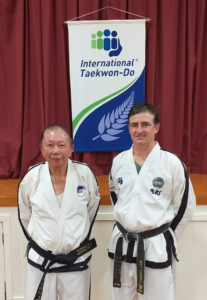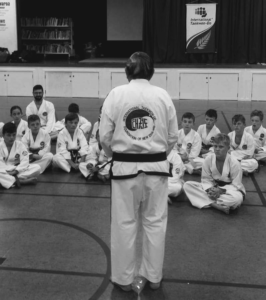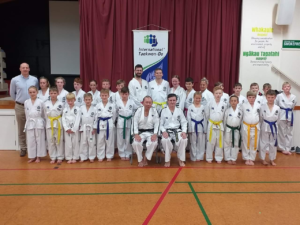
Mr. Norman Ng (IV Dan-Retired) and Mr. Brett Kimberley (V Dan)-Instructor at Ji Shin Maraetai
I had the privilege of being able to speak with Mr. Norman Ng, a pioneer of Taekwon-Do in New Zealand. I was discussing this my my boys (aged 7 and 9), and they decided that they wanted to write to Mr. Ng to ask him some questions.
We had the privilege of not only having him answering their questions, but also agreeing to meet with them at our club, Ji Shin Maraetai.
During his visit he presented the club members with the certificates from their recent grading, took us through his daily warm-up and taught some self-defence techniques.
Here is the letter Zachary and Benjamin sent Mr Ng, and Mr Ng’s reply
My name is Zachary Stockton. I am 7 years old and a white belt, green stripe. I have practiced Taekwon-Do for 10 months. My favourite move is a palm punch.
My name is Benjamin Stockton. I am nine years old. I have been practicing Taekwon-Do for three years and I have just graded to a yellow belt. My favourite move is a side piercing kick.
We would love it if you would answer some questions for us please Sir.
Thank you for your time Sir, and we hope to meet you if you are ever able to visit our club.
Warm regards,
Benjamin and Zachary Stockton
Taekwon!

Mr. Norman Ng instructing club members
Hello Ben and Zac, Thanks for your interest in my Taekwon-Do journey. Here are the answers to your questions:
Q1. When did you start Taekwon-Do?
In 1966 I took Mrs Ng back to her home city of Kuala Lumpur for a visit and managed to get a lecturing position in engineering at the University of Malaya. We were given a subsidized apartment near the town centre in the suburb of Petaing Jaya. As we were taking a stroll one evening, we heard some shouting which aroused our curiosity; a whole lot of people wearing ‘white pyjamas’ were practising punching and kicking etc. The instructor stopped the class to come to talk to us. We were impressed with his courtesy so soon after I joined up for my first Taekwon-Do lesson in the latter part of 1966.
Q2. How old were you when you started Taekwon-Do?
In my class there were mostly male teenagers and adults some of whom were older than me. In the mid 1960’s Taekwon-Do was quite a new martial art and parents did not recognised the benefits of Taekwon-Do training for children and for female. I did a bit of judo when I was at university, so I did not think I was too old to learn a new martial art form at the ripe age of 29.
Q3. What was your teacher’s name?
My instructor Master Koon Lin Low was a kindly man who practised the tenets very well. He was one of the first batch of students to receive the black belt from General Choi Hong Hi, who was the Korean Ambassador to Malaysia in the early 1960’s. I never asked Master Low how old he was when he got his 1st Dan, but I reckoned he must be in his late 30’s.
Q4. What was your dojang called, and where was it?
My first training dojang was on the first floor of a motor cycle shop about 14m x 8m in area with no changing room facilities. Everyone left their clothes and valuables near the wall of the dojang to prevent things from going for a ‘walkabout’. I think the dojang was called Petaling Jaya Taekwon-Do Academy. I thought academy was a nice sounding word so I used it when I established the Palmerston Taekwon-Do Academy in 1970.
Q5. How many hours a day did you train for?
I was a lazy student and I trained very little outside scheduled two training nights per week and 2 hours per session. The training session was continuous and very, very tiring because the weather was so hot and humid that before long one’s dobok was soaked through with sweat. For students of today, they must practise more often to improve the skills.
Q6 How many years did you train for?
I started Taekwon-Do training in 1966 and retired in 1996 when I handed the academy to one of my student to continue to run it. In the first 10 years, there was no one to teach me the patterns beyond Choong Moo. Even with the examiner coming from overseas to conduct grading, there was no opportunity to learn the new patterns nor was I encouraged to go for further grading until the later part of the second decade. That is the reason why I have attained only 4th Dan after nearly 30 years in Taekwon-Do. I do not regret this as I believe a dedicated instructor need not be highly ranked. At that time the International Taekwon-Do Federation did not have any policies with regard to the grading of children to junior black belts. The philosophy was if you are a black belt you should be able to look after yourself. The concept of junior black belts was not introduced until the 1990’s. All my 4 children learned Taekwon-Do but I did not allow them to go for grading until they were teenagers by which time they lost interest and ventured to other sports.
Q7. What is your favourite tenet?
I think all the 5 tenets are very important. One has to practise the 5 tenets to be able to achieve one’s objectives in life and in Taekwon-Do. I think courtesy and integrity are my favourites and one should embrace them throughout one’s life.
Q8. What is your favourite move in Taekwon-Do?
There are so many techniques and moves in Taekwon-Do that one can spend one’s whole life practising them without becoming the perfect practitioner. One of my work mates who was over 185cm tall and who had learned karate wanted to join my class. After a couple of lessons he wanted me to spar with him. We took up the sparring stance and with a right arm block followed by a right knife hand strike I bruised his nose causing it to bleed. I apologised profusely for my lack of control but unfortunately he did not return for further training. Whenever I saw him, I issued the invitation to him to come back but his excuse was that he has no time.
A front kick followed by a jumping front kick can be effective against certain type of students.
Q9. What is your favourite pattern, and why?
The practising of patterns is very important because it helps to improve one’s balance, posture, power and technique execution. Chon Ji and Po-Eun are 2 patterns that can be performed in a confined space such as in a bedroom or the corridor. Chon Ji is a simple but a practical pattern in defence and attack. Po-Eun if done at the right speed can be quite graceful to look at.
The Yoo Sin pattern is very meaningful; some people called Gen Yoo Sin a traitor because he obeyed his king to join up with the forces of Tang Dynasty(from China) to invade the state of Koguryo, but by doing so he helped to unite the whole of Korean peninsula, which eventually drove the Tang Dynasty invaders out of Korea.
I know 18 patterns and even at my age, I still perform these patterns whenever I find time as part of my physical exercises.
Don’t forget to do the warm up exercises before you practise your Taekwon-Do.
Q10. What rank were you when you finished training?
Being an instructor and running a dojang requires commitment and dedication. Because of work and family commitments plus the responsibility of running a dojang there was very little time for me to do extra training. In the early days there was very rare opportunity to be graded beyond 1st Dan black belt as partly explained in Q6. Students of today are very lucky because there are instructors to teach you to the advanced stages: and there are the examiners available to conduct regular grading.
For our 4th Dan grading both Master Evan Davidson and I had to travelled to Brisbane for several days to train and to take the examination in 1989.
Masters McPhail, Davidson and I are responsible for many of the present day black belt grading concepts conceived in 1990.
Q11. What are your best tips for a white belt, and a yellow belt?
For the white and yellow belt students, their main focus should be getting the basics right; good stances, correct blocks, a snap front kick and a power punch.

Jeremy Stockton, 6th Gup, Ji Shin Maraetai
